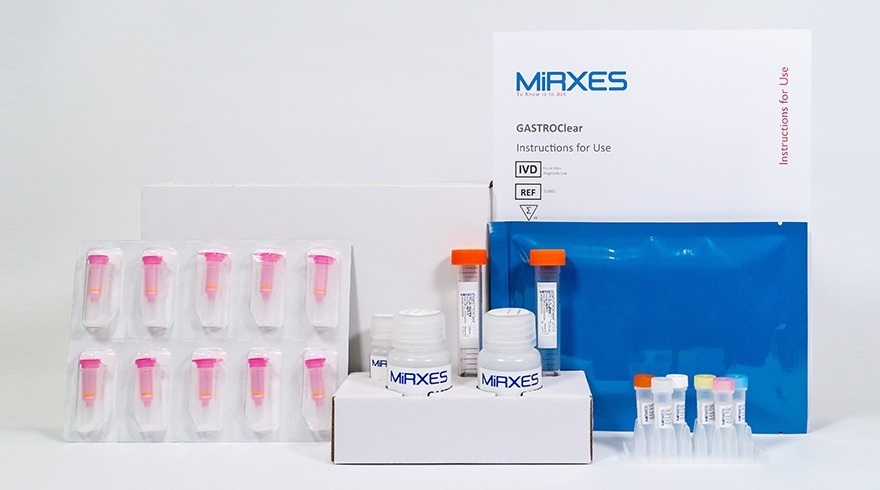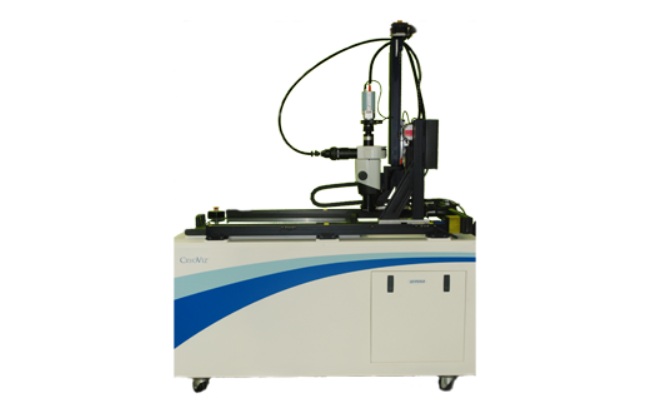MRI Captures Glympathic System in Rat Model
|
By LabMedica International staff writers Posted on 06 Mar 2013 |
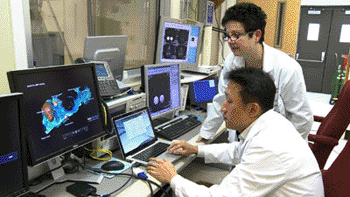
Image: Helene Benveniste, MD, PhD, Professor in the Departments of Anesthesiology and Radiology at Stony Brook University School of Medicine, in her lab with a colleague (Photo courtesy of Stony Brook University).
Magnetic resonance (MR) images are being studied in visualizing the glymphatic system in lab rats that had been given a fluorescent tracer. The whole brain images allowed the investigators to identify two major influx nodes in the brain. Moreover, they could measure the rate at which the fluorescent tracer was removed by the glymphatic system.
The researchers, led by Helene Benveniste, MD, PhD, a professor in the departments of anesthesiology and radiology at Stony Brook University School of Medicine (Stony Brook, NY, USA), published their findings in the February 22, 2013, issue of the Journal of Clinical Investigation. In a companion commentary in the same issue, Dr. Warren Strittmatter of Duke University (Durham, NC, USA) discussed how this new technology could be used to track the development or progression of diseases in which the clearance of specific proteins is impaired.
Dr. Benveniste and colleagues built upon an earlier discovery by Jeffrey Iliff, PhD, and Maiken Nedergaard, MD, PhD, from University of Rochester (NY, USA), who first found and defined the glymphatic pathway, where cerebral spinal fluid (CSF) filters through the brain and exchanges with interstitial fluid (ISF) to clear waste, similar to the way lymphatic vessels clear waste from other organs of the body. In spite of the discovery of the glymphatic pathway, researchers could not see the brain wide flow of this pathway with earlier imaging modalities.
“Our experiments showed proof of concept that the glymphatic pathway function can be measured using a simple and clinically relevant imaging technique,” said Dr. Benveniste. “This technique provides a three-dimensional view of the glymphatic pathway that captures movement of waste and solutes in real time. This will help us to define the role of the pathway in clearing matter such as amyloid beta and tau proteins, which affect brain processes if they build up.”
Dr. Benveniste stated that the pathology of specific neurologic disorders is tied to the buildup of these proteins and other large extracellular aggregates. Specifically, she explained that plaque deposits of these proteins are implicated in the development of Alzheimer’s disease, as well as chronic traumatic encephalopathy that happens after repetitive mild traumatic brain injuries.
The researchers used contrast agents and molecular tracers with MRI to develop the imaging applications. Using these tools, they imaged major regions within the brain such as the cerebellum, orbitofrontal cortex, pineal gland, olfactory bulb, and nasal cavity, to map the entire glymphatic pathway. The contrast-enhanced images reveal the CSF-ISF interchange throughout the whole brain, including pathways in parallel to major arteries that are also involved in the glymphatic waste-clearing process.
The scientists suggested that this sophisticated imaging technique has the potential to be used as a way to monitor the human brain to map brain waste clearance and evaluate disease susceptibility. Dr. Benveniste stressed that, hypothetically, if clinicians were able to capture a defect in the glymphatic system where certain channels are breaking down, plaque formation would likely accelerate. This plaque accumulation may be an early sign of disease susceptibility before evidence of any cognitive changes. Although there is no known way to repair malfunctions in the glymphatic system, the investigators are examining ways to repair or open malfunctioning channels.
Related Links:
Stony Brook University School of Medicine
Duke University
The researchers, led by Helene Benveniste, MD, PhD, a professor in the departments of anesthesiology and radiology at Stony Brook University School of Medicine (Stony Brook, NY, USA), published their findings in the February 22, 2013, issue of the Journal of Clinical Investigation. In a companion commentary in the same issue, Dr. Warren Strittmatter of Duke University (Durham, NC, USA) discussed how this new technology could be used to track the development or progression of diseases in which the clearance of specific proteins is impaired.
Dr. Benveniste and colleagues built upon an earlier discovery by Jeffrey Iliff, PhD, and Maiken Nedergaard, MD, PhD, from University of Rochester (NY, USA), who first found and defined the glymphatic pathway, where cerebral spinal fluid (CSF) filters through the brain and exchanges with interstitial fluid (ISF) to clear waste, similar to the way lymphatic vessels clear waste from other organs of the body. In spite of the discovery of the glymphatic pathway, researchers could not see the brain wide flow of this pathway with earlier imaging modalities.
“Our experiments showed proof of concept that the glymphatic pathway function can be measured using a simple and clinically relevant imaging technique,” said Dr. Benveniste. “This technique provides a three-dimensional view of the glymphatic pathway that captures movement of waste and solutes in real time. This will help us to define the role of the pathway in clearing matter such as amyloid beta and tau proteins, which affect brain processes if they build up.”
Dr. Benveniste stated that the pathology of specific neurologic disorders is tied to the buildup of these proteins and other large extracellular aggregates. Specifically, she explained that plaque deposits of these proteins are implicated in the development of Alzheimer’s disease, as well as chronic traumatic encephalopathy that happens after repetitive mild traumatic brain injuries.
The researchers used contrast agents and molecular tracers with MRI to develop the imaging applications. Using these tools, they imaged major regions within the brain such as the cerebellum, orbitofrontal cortex, pineal gland, olfactory bulb, and nasal cavity, to map the entire glymphatic pathway. The contrast-enhanced images reveal the CSF-ISF interchange throughout the whole brain, including pathways in parallel to major arteries that are also involved in the glymphatic waste-clearing process.
The scientists suggested that this sophisticated imaging technique has the potential to be used as a way to monitor the human brain to map brain waste clearance and evaluate disease susceptibility. Dr. Benveniste stressed that, hypothetically, if clinicians were able to capture a defect in the glymphatic system where certain channels are breaking down, plaque formation would likely accelerate. This plaque accumulation may be an early sign of disease susceptibility before evidence of any cognitive changes. Although there is no known way to repair malfunctions in the glymphatic system, the investigators are examining ways to repair or open malfunctioning channels.
Related Links:
Stony Brook University School of Medicine
Duke University
Latest BioResearch News
- Genome Analysis Predicts Likelihood of Neurodisability in Oxygen-Deprived Newborns
- Gene Panel Predicts Disease Progession for Patients with B-cell Lymphoma
- New Method Simplifies Preparation of Tumor Genomic DNA Libraries
- New Tool Developed for Diagnosis of Chronic HBV Infection
- Panel of Genetic Loci Accurately Predicts Risk of Developing Gout
- Disrupted TGFB Signaling Linked to Increased Cancer-Related Bacteria
- Gene Fusion Protein Proposed as Prostate Cancer Biomarker
- NIV Test to Diagnose and Monitor Vascular Complications in Diabetes
- Semen Exosome MicroRNA Proves Biomarker for Prostate Cancer
- Genetic Loci Link Plasma Lipid Levels to CVD Risk
- Newly Identified Gene Network Aids in Early Diagnosis of Autism Spectrum Disorder
- Link Confirmed between Living in Poverty and Developing Diseases
- Genomic Study Identifies Kidney Disease Loci in Type I Diabetes Patients
- Liquid Biopsy More Effective for Analyzing Tumor Drug Resistance Mutations
- New Liquid Biopsy Assay Reveals Host-Pathogen Interactions
- Method Developed for Enriching Trophoblast Population in Samples
Channels
Clinical Chemistry
view channel
Chemical Imaging Probe Could Track and Treat Prostate Cancer
Prostate cancer remains a leading cause of illness and death among men, with many patients eventually developing resistance to standard hormone-blocking therapies. These drugs often lose effectiveness... Read more
Mismatch Between Two Common Kidney Function Tests Indicates Serious Health Problems
Creatinine has long been the standard for measuring kidney filtration, while cystatin C — a protein produced by all human cells — has been recommended as a complementary marker because it is influenced... Read moreMolecular Diagnostics
view channel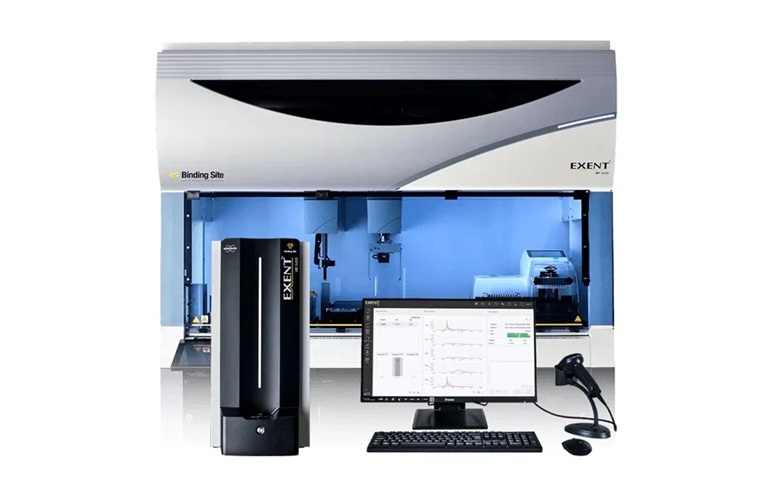
First-Of-Its-Kind Automated System Speeds Myeloma Diagnosis
More than 176,000 people are diagnosed with multiple myeloma worldwide each year, yet the current diagnostic pathway can be slow and uncertain, often relying on a highly subjective interpretation of test results.... Read more
Blood Protein Profiles Predict Mortality Risk for Earlier Medical Intervention
Elevated levels of specific proteins in the blood can signal increased risk of mortality, according to new evidence showing that five proteins involved in cancer, inflammation, and cell regulation strongly... Read moreHematology
view channel
Platelet Activity Blood Test in Middle Age Could Identify Early Alzheimer’s Risk
Early detection of Alzheimer’s disease remains one of the biggest unmet needs in neurology, particularly because the biological changes underlying the disorder begin decades before memory symptoms appear.... Read more
Microvesicles Measurement Could Detect Vascular Injury in Sickle Cell Disease Patients
Assessing disease severity in sickle cell disease (SCD) remains challenging, especially when trying to predict hemolysis, vascular injury, and risk of complications such as vaso-occlusive crises.... Read more
ADLM’s New Coagulation Testing Guidance to Improve Care for Patients on Blood Thinners
Direct oral anticoagulants (DOACs) are one of the most common types of blood thinners. Patients take them to prevent a host of complications that could arise from blood clotting, including stroke, deep... Read moreImmunology
view channel
Gene Signature Test Predicts Response to Key Breast Cancer Treatment
DK4/6 inhibitors paired with hormone therapy have become a cornerstone treatment for advanced HR+/HER2– breast cancer, slowing tumor growth by blocking key proteins that drive cell division.... Read more
Chip Captures Cancer Cells from Blood to Help Select Right Breast Cancer Treatment
Ductal carcinoma in situ (DCIS) accounts for about a quarter of all breast cancer cases and generally carries a good prognosis. This non-invasive form of the disease may or may not become life-threatening.... Read moreMicrobiology
view channel
Rapid Assay Identifies Bloodstream Infection Pathogens Directly from Patient Samples
Bloodstream infections in sepsis progress quickly and demand rapid, precise diagnosis. Current blood-culture methods often take one to five days to identify the pathogen, leaving clinicians to treat blindly... Read more
Blood-Based Molecular Signatures to Enable Rapid EPTB Diagnosis
Extrapulmonary tuberculosis (EPTB) remains difficult to diagnose and treat because it spreads beyond the lungs and lacks easily accessible biomarkers. Despite TB infecting 10 million people yearly, the... Read more
15-Minute Blood Test Diagnoses Life-Threatening Infections in Children
Distinguishing minor childhood illnesses from potentially life-threatening infections such as sepsis or meningitis remains a major challenge in emergency care. Traditional tests can take hours, leaving... Read more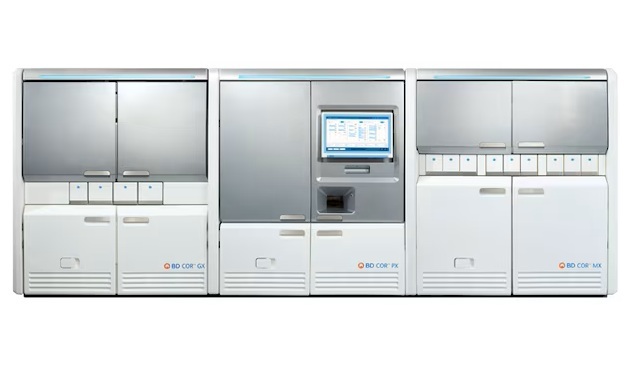
High-Throughput Enteric Panels Detect Multiple GI Bacterial Infections from Single Stool Swab Sample
Gastrointestinal (GI) infections are among the most common causes of illness worldwide, leading to over 1.7 million deaths annually and placing a heavy burden on healthcare systems. Conventional diagnostic... Read morePathology
view channel
AI Tool Outperforms Doctors in Spotting Blood Cell Abnormalities
Diagnosing blood disorders depends on recognizing subtle abnormalities in cell size, shape, and structure, yet this process is slow, subjective, and requires years of expert training. Even specialists... Read more
AI Tool Rapidly Analyzes Complex Cancer Images for Personalized Treatment
Complex digital biopsy images that typically take an expert pathologist up to 20 minutes to assess can now be analyzed in about one minute using a new artificial intelligence (AI) tool. The technology... Read moreTechnology
view channel
AI Saliva Sensor Enables Early Detection of Head and Neck Cancer
Early detection of head and neck cancer remains difficult because the disease produces few or no symptoms in its earliest stages, and lesions often lie deep within the head or neck, where biopsy or endoscopy... Read more
AI-Powered Biosensor Technology to Enable Breath Test for Lung Cancer Detection
Detecting lung cancer early remains one of the biggest challenges in oncology, largely because current tools are invasive, expensive, or unable to identify the disease in its earliest phases.... Read moreIndustry
view channel
Abbott Acquires Cancer-Screening Company Exact Sciences
Abbott (Abbott Park, IL, USA) has entered into a definitive agreement to acquire Exact Sciences (Madison, WI, USA), enabling it to enter and lead in fast-growing cancer diagnostics segments.... Read more













